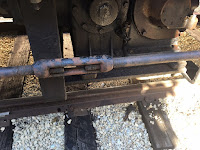Frank writes...
And then there was the truss rod on the L side of the 36, which I'd chipped for only about half its length at some point. This is the "before" view of the turnbuckle, which is a different style than the hexagonal cross-section ones used on the other cars. In the background is the car's trusty D3-EG air compressor.
So what else was happening? Well, here's something exciting. Thomas Slater, who volunteers with the "modern 'L' car" contingent, has designed and brought out a 3D printed prototype for a replacement handle for new-style ball-valve cut-out cocks. Our cars have tons of these cut-outs built with tapered valve bodies, so when they start leaking they're almost impossible to get lapped again. We've had to replace a couple with modern valves (like the one on the left in the above photo). The biggest problem with those is that the handles are these ugly sheet-metal things. So Thomas has designed a handle that looks like the old cast ones but will mate with the modern valve bodies. A plastic prototype is in the middle of the photo. To the right is a reverse key he designed using the same process, but this was 3D printed in brass (!) instead of plastic. The plan is to build a fabricate a few cut-out cock handles in brass to replace the sheet metal ones on our cars. The wonders of modern technology!
And say, what's that big silver loaf of bread-looking thing over in Yard 3? Why, it's the museum's newest acquisition, Western Pacific 801, better known as the "Silver Beaver." No snide remarks, now. This baggage car was built in 1948 for the California Zephyr as part of the WP's contribution to that train. I think it's the first piece of WP equipment at IRM though I could be mistaken on that. Anyway, this car was acquired in place of the scrapped "Olympus," a baggage car commonly assigned to our own Nebraska Zephyr, and just recently arrived in Union. Once it gets fixed up it may make the occasional appearance between the E5 and the "Minerva" but we'll have to see.
In other news, Norm Krentel and some guy from Ohio were doing more metal work on the Michigan Electric car, while the regular "L" car contingent was working on some trouble-shooting on the spam cans. I even got to ride along on a test trip and gawk at a current meter hooked up to the motors which showed how much current was being pulled at any given time. Interesting stuff!









6 comments:
The ability to produce our own replacement cut-out handles is a big step forward. We might also point out that the old-style valves are open when the handle is perpendicular to the pipe, and closed when it's parallel, whereas the modern valves use the opposite system, which is the usual and more obvious arrangement. But it's very confusing for the operator, and potentially disastrous, if the arrangements are mixed, so the handles had to be modified. The new replacement handles will be much appreciated.
I just noticed a milestone: we have now gone over 2,000 posts, for what it's worth.
And a word of thanks to "some guy from Ohio" for driving out all the way to help with the Michigan car. He might be setting a record of some sort.
Should we have some sort of celebration for our 2,000th post?
If we are, is Randall buying?
Would it be possible with the 3D printer to make, in brass the tapered inner portion of the cocks which wear out and cannot be lapped so that new valves do no have to be used? If the could be printed, could they then be machined to seal leak free so that new style valves do not have to be used?
Could that some guy be a long time member from the Dayton area?
I missed the story on the missed opportunity about the Olympus, I had heard that car existed some years ago. Too bad.
Kirk: That's an interesting question. I suspect that doesn't solve the problem if it's the body of the valve that is no longer perfectly conical, but you'd have to know more about 3-D printing and machining that I do to give an answer. In any case, I bet the economics are against it. And if we can just put a new handle on an off-the-shelf valve, that sounds like the way to go.
The body of the valve wears significantly more than the plug. Machining new parts, however created, is a more difficult process than it might appear. These valves were originally made using male/female pairs of tapered reamers to get the necessary accuracy. They could be custom ground, of course, but you'd need a pair for each size of valve. It gets expensive in a hurry. 3-D printing is not able to produce the accuracy or finish required here without standard machining. Putting in a new valve is a "least-bad" way of dealing with this until something better comes along.
R. W. Schauer
Post a Comment